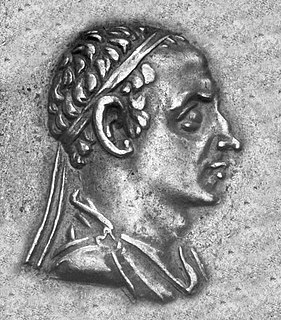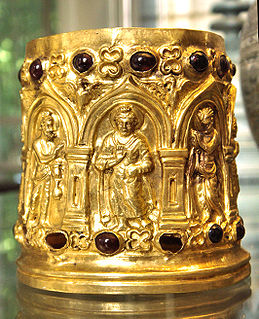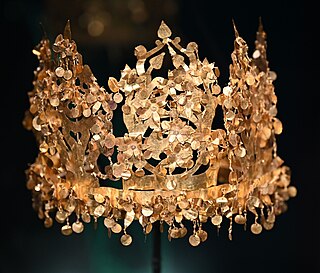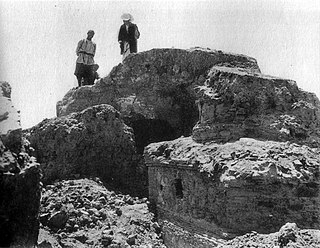
Demetrius I, also called Damaytra was a Greco-Bactrian and later Indo-Greek king, who ruled areas from Bactria to ancient northwestern India. He was the son of the Greco-Bactrian Kingdom's ruler Euthydemus I and succeeded him around 200 BCE, after which he conquered extensive areas in what is now southern Afghanistan, Iran and Pakistan and India.

Menander I Soter, was a Greco-Bactrian and later Indo-Greek King who administered a large territory in the Northwestern regions of the Indian Subcontinent from his capital at Sagala. Menander is noted for having become a patron and convert to Greco-Buddhism and he is widely regarded as the greatest of the Indo-Greek kings.

Kanishka I, or Kanishka the Great, was an emperor of the Kushan dynasty, under whose reign the empire reached its zenith. He is famous for his military, political, and spiritual achievements. A descendant of Kujula Kadphises, founder of the Kushan empire, Kanishka came to rule an empire, extending from Central Asia and Gandhara to Pataliputra on the Gangetic plain. The main capital of his empire was located at Puruṣapura (Peshawar) in Gandhara, with another major capital at Mathura. Coins of Kanishka were found in Tripuri.

Greco-Buddhism, or Graeco-Buddhism, is the cultural syncretism between Hellenistic culture and Buddhism, which developed between the fourth century BCE and the fifth century CE in Gandhara, in present-day north-western Pakistan and parts of north-east Afghanistan. It was a cultural consequence of a long chain of interactions begun by Greek forays into India from the time of Alexander the Great. A few years after Alexander's death, the Easternmost fringes of the empire of his general Seleucus were lost in a war with the Mauryan Empire, under the reign of Chandragupta Maurya. The Mauryan Emperor Ashoka would convert to Buddhism and spread the religious philosophy throughout his domain, as recorded in the Edicts of Ashoka. This spread to the Greco-Bactrian kingdom, which itself seceded from the Seleucid empire. Within its borders, the Greek fondness for statuary produced the first statues of the Buddha, leading ultimately to the modern tradition.

The Kharosthi script, also spelled Kharoshthi or Kharoṣṭhī also known as 'Indo-Bactrian' script was an writing system originally developed in present-day northern Pakistan, sometime between the 4th and 3rd century BCE. Kharosthi was an ancient Indo-Iranian script used by various Indo-European peoples in present-day northern Pakistan and eastern Afghanistan. It was used in Central Asia as well. An abugida, it was introduced at least by the middle of the 3rd century BCE, possibly during the 4th century BCE, and remained in use until it died out in its homeland around the 3rd century CE.

The Greco-Buddhist art or Gandhara art of the north Indian subcontinent is the artistic manifestation of Greco-Buddhism, a cultural syncretism between Ancient Greek art and Buddhism.

Agathocles I Dikaios was an ephemeral Greco-Bactrian/Indo-Greek king, who reigned between around 190 and 180 BC, likely of the dynasty of Diodotus I, due to his commemoration of Antiochos Nikator.

Indo-Scythians were a group of nomadic Iranian peoples of Scythian origin who migrated from Central Asia southward into northern and western regions of ancient India from the middle of the 2nd century BCE to the 4th century CE.

Antialcidas Nikephoros was a king of the Indo-Greek Kingdom, who reigned from his capital at Taxila. Bopearachchi has suggested that he ruled from ca. 115 to 95 BCE in the western parts of the Indo-Greek realms, whereas R. C. Senior places him around 130 to 120 BCE and also in eastern Punjab. Senior does however believe that he ruled in tandem with King Lysias.

The Bimaran casket or Bimaran reliquary is a small gold reliquary for Buddhist relics that was found inside the stupa no.2 at Bimaran, near Jalalabad in eastern Afghanistan.

Sodasa was an Indo-Scythian Northern Satrap and ruler of Mathura during the later part of the 1st century BCE or the early part of 1st century CE. He was the son of Rajuvula, the Great Satrap of the region from Taxila to Mathura. He is mentioned in the Mathura lion capital.

Tillya tepe, Tillia tepe or Tillā tapa is an archaeological site in the northern Afghanistan province of Jowzjan near Sheberghan, excavated in 1978 by a Soviet-Afghan team led by the Soviet archaeologist Viktor Sarianidi. The hoard found there is often known as the Bactrian gold.

Ahan Posh or Ahan Posh Tape is an ancient Buddhist stupa and monastery complex in the vicinity of Jalalabad, Afghanistan, dated to circa 150-160 CE, at the time of the Kushan Empire.

The Indo-Greeks practiced numerous religions during the time they ruled in present-day northwestern India from the 2nd century BCE to the beginning of the 1st century CE. In addition to the worship of the Classical pantheon of the Greek deities found on their coins, the Indo-Greeks were involved with local faiths, particularly with Buddhism, but also with Hinduism and Zoroastrianism.
Afghanistan possesses a rich linguistic legacy of pre-Islamic scripts, which existed before being displaced by the Arabic alphabet, after the Islamic conquest of Afghanistan. Among these scripts are Sharada, Kharosthi, Greek, and Brāhmī. For thousands of years, Afghanistan was inhabited by Indo-Aryan and Iranian peoples and thus all ancient documents, tracts, monuments and remains are of Hindu and Iranian origins. Later, Buddhism became the major force in Afghanistan and brought with it its own liturgical languages.

The Northern Satraps, or sometimes Satraps of Mathura, or Northern Sakas, are a dynasty of Indo-Scythian rulers who held sway over the area of Eastern Punjab and Mathura after the decline of the Indo-Greeks, from the end of the 1st century BCE to the 2nd century CE. They are called "Northern Satraps" in modern historiography to differentiate them from the "Western Satraps", who ruled in Gujarat and Malwa at roughly the same time and until the 4th century CE. They are thought to have replaced the last of the Indo-Greek kings in the Eastern Punjab, as well as the Mitra dynasty and the Datta dynasty of local Indian rulers in Mathura.

The Post-Mauryan coinage of Gandhara refers to the period of coinage production in Gandhara, following the breakup of the Maurya Empire. When Mauryan central power disappeared, several small independent entities were formed, which started to strike their own coins, defining a period of Post-Mauryan coinage that ends with the rise of the Gupta Empire in the 4th century CE. This phenomenon was particularly precocious and significant in the area of Gandhara in the northwest, and more particularly in the city of Taxila, in modern-day Pakistan.

Gandhāran Buddhism refers to the Buddhist culture of ancient Gandhāra which was a major center of Buddhism in the Indian subcontinent from the 3rd century BCE to approximately 1200 CE. Ancient Gandhāra corresponds to modern day north Pakistan, mainly the Peshawar valley and Potohar plateau as well as Afghanistan's Jalalabad. The region has yielded the Gandhāran Buddhist texts written in Gāndhārī Prakrit the oldest Buddhist manuscripts yet discovered. Gandhāra was also home to a unique Buddhist artistic and architectural culture which blended elements from Indian, Hellenistic, Roman and Parthian art. Buddhist Gandhāra was also influential as the gateway through which Buddhism spread to Central Asia and China.

Tepe Sardar, also Tapa Sardar or Tepe-e-Sardar, is an ancient Buddhist monastery in Afghanistan. It is located near Ghazni, and it dominates the Dasht-i Manara plain. The site displays two major artistic phases, an Hellenistic phase during the 3rd to 6th century CE, followed by a Sinicized-Indian phase during the 7th to 9th century.

Tepe Maranjan was a Buddhist monastery, located on the eastern outskirst of Kabul, and dated to the 4th century CE, or the 6-7th century for the Buddhist phase. Many Buddhist sculptures were discovered on the site. They are made of clay, and stylistically derived from the sculptures of Hadda, but preceded the style of the Fondukistan monastery. Tepe Maranjan can be considered as representative of the Art of Gandhara of the 5th or 6th century CE.



















